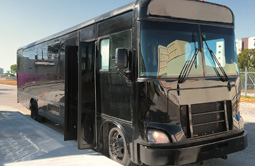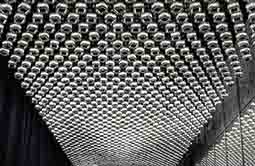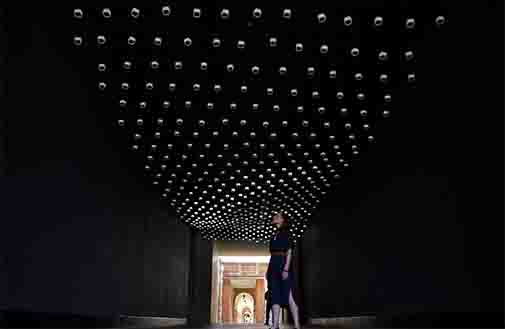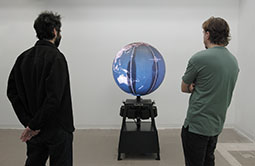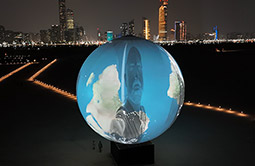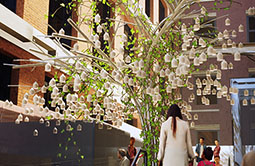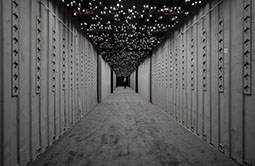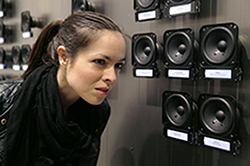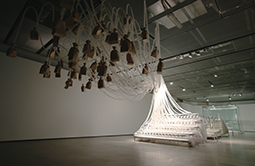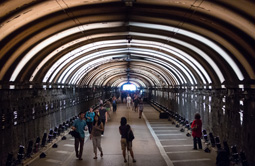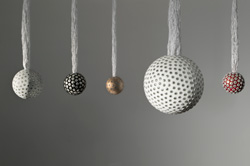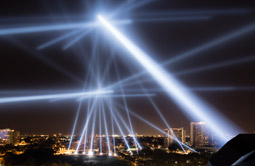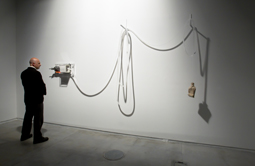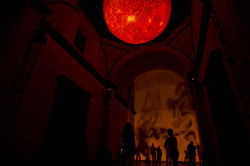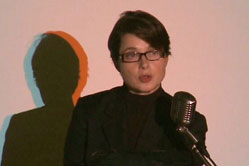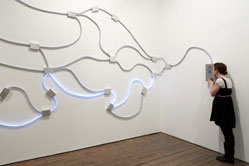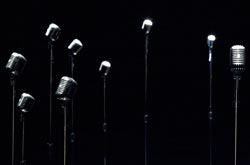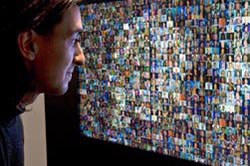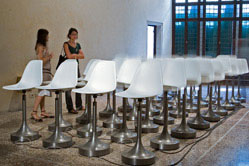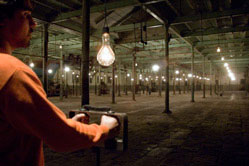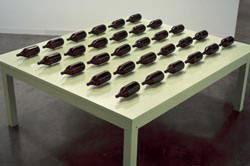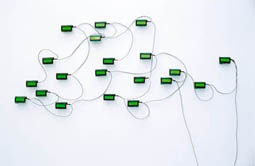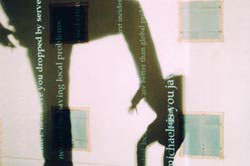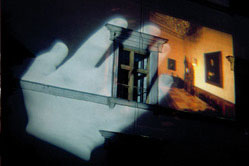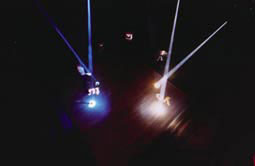Dark Ride
2024
“Dark Ride” was a sound-art performance originally conceived for Laumeier Sculpture Park in St-Louis. The piece was intended as a “social sculpture” to remedy the lack of public transport that could bring visitors from segregated and disadvantaged areas of metropolitan St Louis, Ferguson for example, to Laumeier Park, situated in the city’s affluent suburbs. During the free ride, passengers in the darkened bus would listen to a geolocated and performed soundtrack that changed for every trip.
View details.
View details.
Pulse Voronoi
2024
One cubic metre of crystal explodes into 7,000 unique but complementary shards, expelled in all directions. "Pulse Voronoi" proposes a walk through the resulting cloud of crystals, shortly after the blast. The crystals are suspended in the room, each with a warm light that glimmers rhythmically to the recorded heartbeat of a different participant from the past. Five pulse sensors placed around the room detect visitors' heartbeats which can be heard in the room and seen in surrounding lights. Every new recording of vital signs deletes the oldest one, creating a memento mori.
View details.
View details.
Kristallstimmen
2024
An interactive installation for Swarovski’s “Crystal Worlds Museum” in Wattens, Austria, features an array of 3,000 suspended loudspeakers, each clad in hundreds of small black crystals that get illuminated when in use. As visitors traverse the space, sensors detect their presence and turn on the speaker directly above them, which lights up and plays a voice message. Each loudspeaker contains a recording from a different company employee from around the world, speaking in their native language about their relationship to crystal, with over 100 languages represented. When no visitor is present, the installation is silent.
View details.
View details.
Climate Parliament
2024
“Climate Parliament” is an interactive sound and light installation featuring thousands of audio channels playing on small, custom-made loudspeakers, suspended under the ceiling of a semi-outdoor passageway at Rice University. The speakers are hung out of reach of passers-by in a regular, but staggered formation that creates semi-circular archways with a six-foot radius.
View details.
View details.
Shadow Tuner - Standalone
2024
An animated image of the Earth rotates on a sphere. As people approach and move around it, their movements are tracked and reflected on the sphere as black shadows. As shadows cover different cities, they automatically trigger live, local radio stations from those locations, thus creating a global polyphonic tuning device. This artwork is available as both an inflatable public sculpture and a standalone domestic piece.
View details.
View details.
Shadow Tuner
2023
An animated image of the Earth rotates on a sphere. As people approach and move around it, their movements are tracked and reflected on the sphere as black shadows. As shadows cover different cities, they automatically trigger live, local radio stations from those locations, thus creating a global polyphonic tuning device. This artwork is available as both an inflatable public sculpture and a standalone domestic piece.
View details.
View details.
Pulse Topology
2021
“Pulse Topology” uses remote photoplethysmography (PPG) technology, developed to detect heartbeats without using touch. The biometric data collected from participants is used to illuminate 3,000 to 10,000 suspended light bulbs, creating an immersive audio-visual experience which forms a connective topography of the pulses of participants.
View details.
View details.
Speaking Willow
2020
“Speaking Willow” is a sound sculpture in the shape of a weeping willow tree, between 16 and 20 feet high, which adorns the entrance of the Planet Word Museum. The tree sculpture is fabricated in aluminum and is hollow, except the trunk and branches carry inside data cables that emerge from the structure and hang vertically, slowly swaying with the wind. The tree is covered by living vine, Ivy or other evergreen climbing plants that warm-up the design.
View details.
View details.
Field Atmosphonia
2020
“Field Atmosphonia” is a sound and light environment featuring 3,000 audio channels playing on custom-made speakers with LED lights. The project is a soundscape that comes in waves of complex polyphonies that emerge from the array of field recordings.
View details.
View details.
Border Tuner / Sintonizador Fronterizo
Relational Architecture 23, 2019
"Border Tuner" is a large-scale, participatory art installation designed to interconnect the cities of El Paso, Texas, and Ciudad Juárez, Chihuahua. Powerful searchlights make “bridges of light” that open live sound channels for communication across the US-Mexico border. The piece creates a fluid canopy of light that can be modified by visitors to six interactive stations, three placed in El Paso and three in Juárez.
View details.
View details.
Linear Atmosphonia
2019
“Linear Atmosphonia” is a sound environment featuring 3,000 audio channels playing on separate custom-made speakers with LED lights. The piece can be presented as a tunnel or room, and the recordings change typology gradually along the field of speakers: recordings include wind, water, fire, ice, over 200 types of insects, over 300 types of birds, bells, metronomes, bombs and so on. The project results in waves of complex polyphonies that emerge from the array of field recordings.
View details.
View details.
Sphere Packing: Bach
2018
A 3m diameter sphere that supports 1,128 loudspeakers each of which plays a different composition by Johann Sebastian Bach. The piece is designed to concentrate Bach’s entire musical production in a dense multi-channel structure that visitors can enter. At any given point, all compositions play-back simultaneously creating a polyvocal and complex sound environment focused in the centre of the sphere; from time to time the speakers are gradually silenced in waves to highlight one speaker playing a single composition.
View details.
View details.
Polar
2018
A circular display that converts a camera’s cartesian grid of photo sensors into a representation in polar coordinates (an angle and a distance). The piece has a radar-like rotation mapped to the baseline of the live camera to add an element of time, emphasized by a quiet ticking sound. The polar distortion produces an anamorphic representation of people in front of the work, with all of them sharing the same origin.
View details.
View details.
Population Theatre
2016
"Population Theatre" is a scalable data-visualization theatre consisting of 7.5 billion individual computer-controlled points of light. The purpose of the piece is to create an experience that offers a one-to-one relationship between the world’s population and its data: every person is represented by a single point of light. "Population Theatre" is a platform for making data tangible, a direct representation of demographic data, and as such it can be used to create "data-dramatizations" that may help the public visualize data on political economy, cultural studies, sociology, anthropology, psychology, history, communications and other fields. People may stand on the stage and watch data performances, but they are also encouraged to walk along the corridors amongst the "rows" of monitors, physically "zooming-in" to see individual pixels, subverting the panoptic view and looking back at the public on the stage.
View details.
View details.
Pulse Corniche
Relational Architecture 22, 2015
“Pulse Corniche” (Relational Architecture 22) was an interactive canopy of powerful light beams projected into to the sky by robotic searchlights whose brightness and orientation was controlled by the heart-rate of visitors to the Abu Dhabi’s Corniche. People were free to participate by holding a sensor placed in the centre of the plaza that converted the electrical activity of their heart into a unique lighting sequence. The intensity and direction of the lights visualized the different biometric rhythms of each participant, in an urban scale.
View details.
View details.
Pan-Anthem
Subsculpture 16, 2014
"Pan-Anthem" (Subsculpture 16) is an interactive sound installation where the national anthem of every country in the World plays back on a movable speaker that is magnetically attached to a large wall. The speakers are precisely arranged to visualize national statistics: population, GDP, area, number of women in parliament, GINI, year of independence, HDI and so on.
For example, when the work is configured to show military spending per capita, on the far left of the wall the public can hear the anthems of countries without military forces like Costa Rica, Iceland and Andorra while at the far right they can hear Saudi Arabia, Israel and the United States, which spend more than $2,000 per person per year. If no one is in the exhibition room all the speakers are silent, but as a visitor approaches a particular set of speakers these start playing automatically, creating a positional panoramic playback of anthems associated to similar statistics.
View details.
View details.
Vicious Circular Breathing
2013
“Vicious Circular Breathing” is a hermetically-sealed apparatus that invites the public to breathe the air that was previously breathed by participants before them. The installation consists of a glass room with double sliding doors, two emergency exits, carbon dioxide and oxygen sensors, a set of motorized bellows, an electromagnetic valve system, and 61 brown paper bags hanging from respiration tubes. In the piece, visitors’ breath is kept circulating and made visible by automatically inflating and deflating the brown paper bags around 10,000 times a day, the normal respiratory frequency for an adult at rest. The piece includes warnings for asphyxiation, contagion and panic, and produces a faint mechanical sound, a quiet whir from the air flow and louder crackles from the crumpling bags.
View details.
View details.
Voice Tunnel
Relational Architecture 21, 2013
“Voice Tunnel” (Relational Architecture 21) was an installation designed to transform the Park Avenue Tunnel in New York City with 300 theatrical spotlights that produce glimmering arches of light along the tunnel’s walls and ceiling. Participants control the intensity of each light by speaking into an intercom at the tunnel’s center which records their voice and loops it. Louder speech increases the lights’ brightness proportionally, creating a Morse-like code of flashes throughout the tunnel. The individual voices can be heard as pedestrians walk through the tunnel, on 150 loudspeakers, one beside each light arch and synchronized with it. At any given time, the tunnel is illuminated by the voices of the past 75 participants: as new participants speak into the intercom, older recordings get pushed away by one position down the array of light fixtures until they leave the tunnel, so that the content of the piece is changing constantly.
View details.
View details.
Zero Noon
2013
"Zero Noon" is a digital clock that shows the current time according to eccentric metrics: it uses hundreds of different internet-refreshed statistics. The clock's reference systems are all synchronized so that precisely at noon they all zero and start over. The public may change the statistics by manually scrolling through the list using small push-buttons under the built-in display. The metrics come from government data, Harper’s Magazine, financial institutions, NGOs, academic studies and other trusted sources.
View details.
View details.
Sphere Packing
Subsculpture 15, 2013
"Sphere Packing" (Subsculpture 15) is a series of 3D-printed pieces designed to concentrate the entire musical production of a composer in a single dense multi-channel device. The size of each sphere is directly proportional to how prolific the composer was; for example the sphere for Hildegaard Von Bingen has an 11 cm diameter and 69 loudspeakers. The project presents at a glance the comparative production volume of many composers. As people are a couple of metres away from a sphere, they hear a quiet murmur of sounds, but as they approach and put their ears up close to individual speakers, they can hone in on specific compositions.
View details.
View details.
Airborne Newscasts
Relational Architecture 20, 2013
"Airborne Newscasts" (Relational Architecture 20) is an interactive installation originally commissioned by the Chrysler Museum of Art to transform Norfolk, Virginia’s public space into a poetic shadow play. By blocking the light of two projectors, participants cast their shadows onto a 900-square-metre wall, and these shadows are tracked by computerized surveillance systems. Out of the shadows emanate billowing smoke which is mapped onto the wall, slowly accumulating within it. Turbulent clouds of live newscasts evaporate from the “heat” of the tracked bodies.
View details.
View details.
Open Air
Relational Architecture 19, 2012
“Open Air” (Relational Architecture 19) was an interactive artwork that allowed participants’ voices to transform the sky over Philadelphia. Using a website or a free iPhone app participants could record a voice message and listen to and rate other entries. The messages were played-back over the Benjamin Franklin Parkway using 24 powerful robotic searchlights that reacted, both in brightness and position, to the voice’s frequency and volume as well as to the phone's GPS location.
View details.
View details.
Last Breath
2012
“Last Breath” is an installation designed to store and circulate the breath of a person forever. The piece consists of a small brown paper bag which inflates and deflates automatically thanks to motorized bellows similar to those found in artificial respirators in hospitals. The apparatus hangs on a wall and is activated 10,000 times a day, the typical respiratory frequency for an adult at rest, including 158 sighs.
View details.
View details.
Voice Array
Subsculpture 13, 2011
In “Voice Array” (Subsculpture 13), as a participant speaks into an intercom, his or her voice is automatically translated into flashes of light and then the unique blinking pattern is stored as a loop in the first light of the array. Each new recording pushes all previous recordings one position down and gradually one can hear the cumulative sound of the 288 previous recordings. The voice that was pushed out of the array can then be heard by itself.
View details.
View details.
Nave Solar
2011
“Nave Solar” is an interactive installation featuring a fake Sun that is activated by the pendular motion of the public as they hang from a rope and swing along the nave of a 16th Century catholic inquisition church. Using tracking systems, the installation detects the motion of participants and generates smoke that accumulates on the ceiling of the apse as well as activates the Sun's flares, surface turbulence and sun spots.
View details.
View details.
Solar Equation
Relational Architecture 16, 2010
"Solar Equation" is a large-scale public art installation that consists of a faithful simulation of the Sun, 100 million times smaller than the real thing. Commissioned by the Light in Winter Festival in Melbourne, the piece features the world’s largest spherical balloon, custom-manufactured for the project, which is tethered over Federation Square and animated using five projectors. The solar animation on the balloon is generated by live mathematical equations that simulate the turbulence, flares and sunspots that can be seen on the surface of the Sun. This produces a constantly changing display that never repeats itself, giving viewers a glimpse of the majestic phenomena that are observable at the solar surface and that only relatively recent advances in astronomy have discovered. Using an iPhone, iPod touch or iPad, people may disturb the animations in real-time and select different fluid dynamic visualizations.
View details.
View details.
Levels of Nothingness
Performers 1, 2009
"Levels of Nothingness" is an installation-performance commissioned for the 50th Anniversary of the Guggenheim Museum, inspired by Kandinsky's opera, "The Yellow Sound" (1912). In "Levels of Nothingness", the human voice is analyzed by computers, automatically controlling a full rig of Rock-and-Roll concert lighting and creating an interactive colour show. For the New York performances, Isabella Rossellini read a libretto co-written by Brian Massumi, which included seminal philosophical texts on skepticism, color and perception, including writings by Kandinsky, Deleuze, Sanches, Simon Baron-Cohen and Alexander Luria. Following the performances, audience members could test the color-generating microphone.
View details.
View details.
Voz Alta
Relational Architecture 15, 2008
"Voz Alta" (Loud Voice)(Relational Architecture 15) is a memorial commissioned for the 40th anniversary of the student massacre in Tlatelolco. Participants who speak into a megaphone automatically control the brightness of four searchlights that relay their voice over Mexico City as quiet light flashes; tuning into 96.1FM radio allows people anywhere in the city to listen in live to what the lights are saying.
View details.
View details.
Less Than Three
2008
"Less than Three" is an interactive installation of light strips that form a network between two intercoms. As a participant speaks into an intercom, their voice is translated into corresponding flashes of light and this light pattern is transmitted visually along one of the several possible pathways through the network. When it reaches the other side, the viewer's phrase is once again released as sound. Several voices can be carried simultaneously and the short contributions going fast through the network and the longer ones taking longer.
View details.
View details.
Microphones
Subsculpture 10, 2008
"Microphones" (Subsculpture 10) is an interactive installation featuring one or several 1939-vintage Shure microphones, placed on mic stands around the exhibition room at different heights. Each microphone has been modified so that inside its head is a tiny loudspeaker and a circuit board connected to a network of hidden control computers. When a public member speaks into a microphone, it records his or her voice and immediately plays back the voice of a previous participant, as an echo from the past.
View details.
View details.
Reporters With Borders
Shadow Box 6, 2007
"Reporters With Borders" (Shadow Box 6) is a high-resolution interactive display that simultaneously shows 864 video clips of news anchors taken from TV broadcasts in the United States and Mexico. As the viewer stands in front of the piece his or her silhouette is shown on the display and within it reporters begin to talk. Every 5 minutes the piece switches the video clips - from a database of 1600 - and classifies them along gender, race and country, so that for instance on the left there are only American reporters and on the right only Mexicans.
View details.
View details.
Wavefunction
Subsculpture 9, 2007
"Wavefunction" (Subsculpture 9) is a kinetic sculpture comprised of fifty to one hundred Charles and Ray Eames moulded chairs (designed in 1948) and placed in a regular array of rows, facing the entrance to the exhibition space. When someone approaches the work, a computerised surveillance system detects their presence and the closest chairs automatically begin to lift off the ground, creating the crest of a wave that then spreads over the whole room.
View details.
View details.
Pulse Room
2006
"Pulse Room" is an interactive installation featuring one to three hundred clear incandescent light bulbs, 300 W each and hung from a cable at a height of three metres. The bulbs are uniformly distributed over the exhibition room, filling it completely. An interface placed on a side of the room has a sensor that detects the heart rate of participants. When someone holds the interface, a computer detects his or her pulse and immediately sets off the closest bulb to flash at the exact rhythm of his or her heart.
View details.
View details.
Synaptic Caguamas
Subsculpture 4, 2004
"Synaptic Caguamas" (Subsculpture 4) is a kinetic sculpture consisting of a motorized Mexican "cantina" bar table with 30 "Caguama"-sized beer bottles (1-litre each). The bottles spin on the table with patterns generated by cellular automata algorithms that simulate the neuronal connections in the brain. Every few minutes the bottles are reset automatically and seeded with new initial conditions for the algorithm, so that the movement patterns are never repeated.
View details.
View details.
Body Movies
Relational Architecture 6, 2001
"Body Movies" transforms public space with interactive projections measuring between 400 and 1,800 square metres. Thousands of photographic portraits, previously taken on the streets of the host city, are shown using robotically controlled projectors. However the portraits only appear inside the projected shadows of the passersby, whose silhouettes can measure between two and twenty-five metres depending on how close or far away they are from the powerful light sources positioned on the ground.
View details.
View details.
33 Questions per Minute
Relational Architecture 5, 2000
"33 Questions Per Minute" (Relational Architecture 5) consists of a computer program which uses grammatical rules to combine words from a dictionary and generate 4.7 trillion unique, fortuitous questions. The automated questions are presented at a rate of 33 per minute—the threshold of legibility. The system will take over 271,000 years to ask all possible questions.
View details.
View details.
Re:Positioning Fear
Relational Architecture 3, 1997
"Re:Positioning Fear" (Relational Architecture 3) was a large-scale installation on the Landeszeughaus military arsenal with a "teleabsence" interface of projected shadows of passers-by. Using tracking systems, the shadows were automatically focused and generated sounds. A real-time IRC discussion about the transformation of the concept of "fear" was projected inside the shadows; the chat involved 30 artists and theorists from 17 countries.
View details.
View details.
Displaced Emperors
Relational Architecture 2, 1997
"Displaced Emperors" (Relational Architecture 2) was an interactive installation that used an "architact" —architecture meets haptics— interface to transform the facade of the Habsburg Castle in Linz, Austria. Wireless 3D sensors calculated where participants pointed to on the façade and a large animated projection of a hand was projected at that location. As people on the street "caressed" the building, they could reveal the interiors of the Habsburg residence in Mexico City, Castillo de Chapultepec.
View details.
View details.
The Able Skin
1997
"The Able Skin" is a media structure designed by architect Emilio López-Galiacho to hide any emblematic building that is not allowed to have a natural death, that is kept alive artificially through restoration, citation and simulation. A virtual reality installation allows participants to tour the first Able Skin, which covers Palladios Villa Rotonda. The participant's motion controls the point of view in the projected environments on the wall and the floor.
View details.
View details.
The Trace
1995
"The Trace" is a telepresence installation that invites two participants in remote sites to share the same telematic space. The piece consists of light vectors, sounds and graphics that respond to the movement of the participants. Two interactive stations are needed for the piece; these are interconnected with a normal ISDN digital line so they can be in the same exhibition hall, on either side of a city or in different cities.
View details.
View details.
